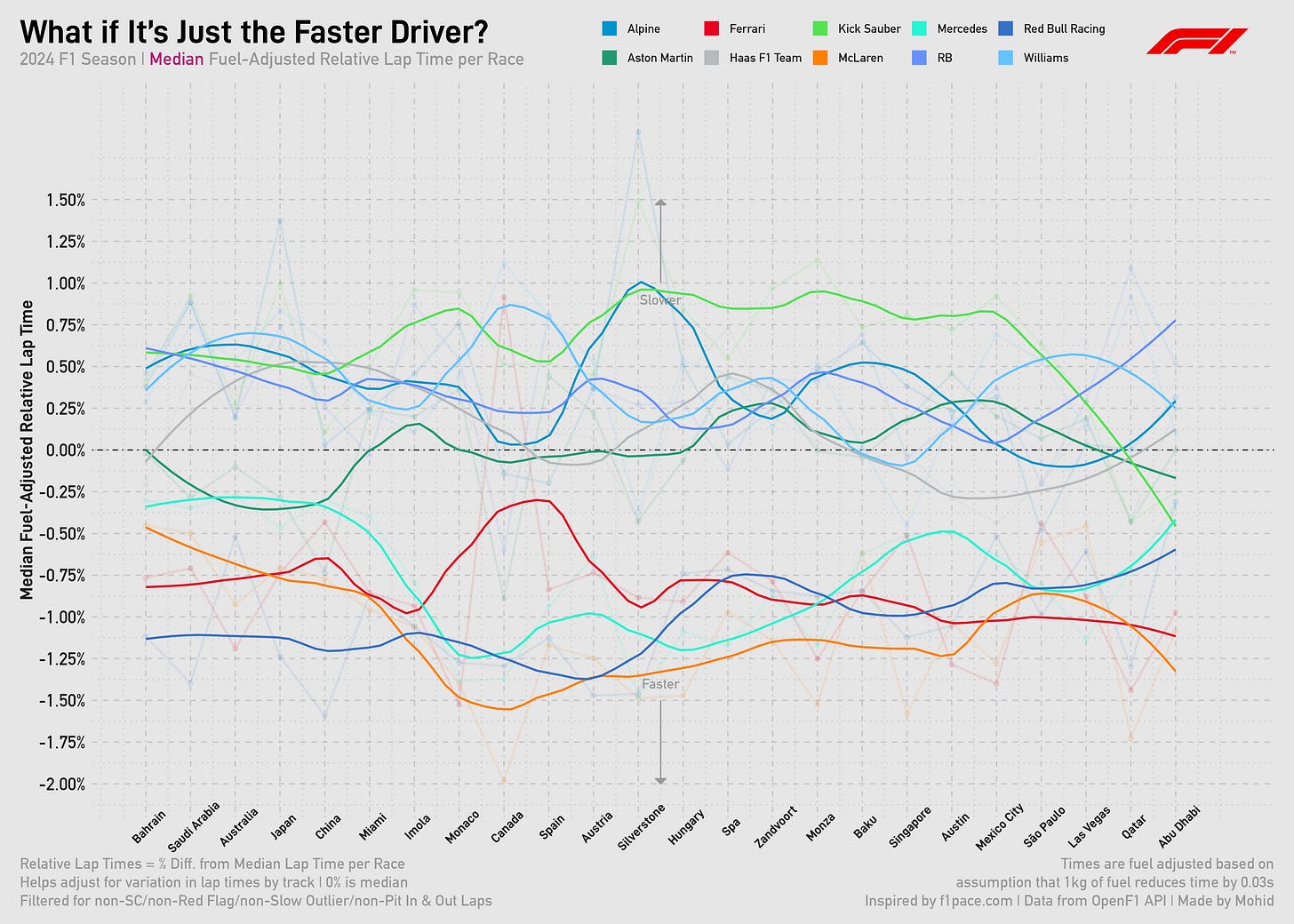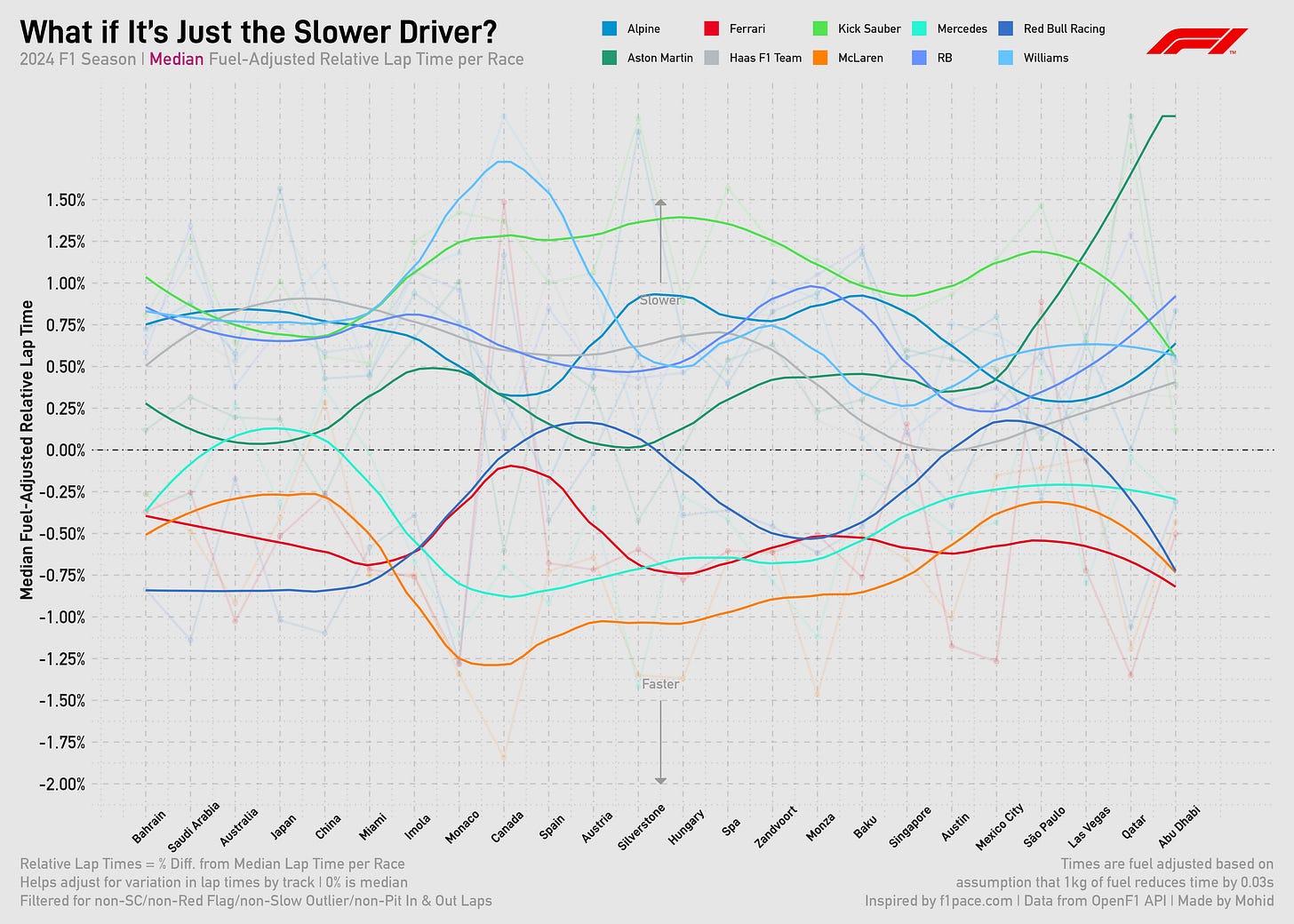[Race] 2024 F1 Team Analysis
With about a week until the first race weekend of 2025, let's take a look at which teams were the fastest in the record-setting 2024 season.
Last season, we had some things new and some things all the same as McLaren ended a 26 year wait for a WCC title while Ferrari finished second for the 7th time since their 2008 title win. Max Verstappen might’ve won his 4th title in a row but Red Bull could not repeat their 2013 feat of four Constructor’s titles in a row. This was also the latest the WCC had been clinched in a season since that night in Abu Dhabi. This was the first year since 1990 where four teams had multiple race wins and the first year since 1977 to have four teams with 3+ race wins.
McLaren entered the year having ended the last one as the second fastest team (see below), but their early 2024 form didn’t take off until Lando Norris’s win in Miami. Red Bull plummeted down the order after the opening series of races which had seemed to signal a continuation of Max Verstappen’s dominance. Ferrari had to settle for second even while a few dubious FIA decisions gave the last race quite a bit of weight (Norris and all those Qatar penalties).
Ferrari arguably ended the season as the fastest car, so it’s surprising to hear that they have (nearly) completely changed the car this year. It becomes less surprising when you hear Andrea Stella’s saying the McLaren is ‘fundamentally different.’ Given the Woking outfit took a big step back from Abu Dhabi 2023 to Bahrain 2024, these big changes in the last year of this current set of regulations is a fairly sizable risk.
Max Verstappen saying “I don’t think we can compete for victory in Melbourne,” isn’t anything a RBR fan wants to hear, either. Mercedes are an interesting topic with George Russell set to become the outright number one (if Kimi Antonelli doesn’t have something to say about that).
The midfield is also looking fairly wide open with Williams showing out well in pre-season testing (though all that should be taken with a massive grain of salt).
That’s all this season, though. Let’s look at last season.
Race Pace
Year-Long Pace
First, a couple disclaimers. I used median as the average because Formula 1 has a tendency for outlier laps, thus making sure I get an accurate assessment of the quickest teams means I need to make sure those outliers are accounted for. In the same vein, I’ve filtered out laps under Safety Car, Red Flag, and Yellow Flags, alongside removing laps where a driver was uncharacteristically slow (think, around 30 seconds slower than their other slowest time at a given race).
The overall race pace is adjusted for race distances by using percent variation from median rather than actual times. This helps assure that races of varying lengths are being compared equally. I’ve also adjusted lap times for fuel so we get a more equalized view of how quick a team was on every lap in a race.
Along the same lines as the driver-analysis, here’s the overall speed comparison by team:

Takeaways:
If you use the mean as the measure of average, Red Bull actually shows as a little faster than Ferrari, but that’s largely because of how bad Ferrari was in Canada, which we’ll see in a bit.
Sauber was by far the worst team on the grid—it’s actually remarkable how bad they were.
The midfield was quite exciting:
Haas were unlucky to finish behind Alpine in the Constructor’s based on one result (Brazil).
Aston Martin kinda rode their early-season form to finish at the top of the midfield.
Williams probably the most consistently ‘mid’ team on the field and they’re so far back because of it.
That Mercedes winning races is remarkable (though understandable when you see the next graph).
Race-by-Race Speed
The solid lines are smoothed regression lines to show trends over the course of the season, the faded straight lines in the back are the actual race pace per team.
Notes:
I added some in-graph notes for specific things I feel were, well, notable.
Haas’s uptick in speed in the second half of the season was great to see, hopefully they can keep that going with Esteban Ocon and Oliver Bearman in the hot seats, now.
Mercedes were the second fastest team for a pretty decent span. Their year-long pace is heavily detracted from because of their early- and late-season form.
Again, that Ferrari performance in Canada set them back an insane amount.
You can also see why I’d argue that the Ferrari was the fastest car at the end of the season, they managed to outpace the McLaren for a good couple races.
The only race McLaren won without being the fastest was in Baku (because of Piastri’s great defense on Leclerc).
If they want to go back-to-back in the WCC and have a chance at the WDC, their drivers need to grind out wins without having the fastest car.
An Experiment
Now, I think using both drivers at a race weekend to estimate a team’s true pace is much better than just the fastest driver. This helps account for position, dirty air, strategy, and a whole lot more that one driver alone would not be able to handle.
But for a little statistical experiment, I went and plotted Red Bull’s pace discounting Sergio Perez (so with only Max representing the team). Here’s what that looks like:
The difference is quite stark. A couple terrible performances in that late-first-half-of-the-season span meant RBR’s median pace fell off a cliff even while Verstappen managed to maintain it somewhat. Max challenging the Ferrari in the late-second-half-of-the-season span is also quite remarkable.
Getting rid of Perez was the right move. The question is only whether replacing him with Lawson (over Tsunoda—or even Colapinto) is the right one (maybe that’s something worth looking into, hmm).
For fairness, here’re the rest of the teams if only the faster driver represented their pace:
This doesn't mean much in the grand scheme of things and the chart using both drivers’ pace is a much better estimate of each team’s pace at a given race, but it’s interesting to look at.
Here’s the chart if we count only the slower driver:
McLaren seems to have had the best ‘floor’ over the course of the season. Maybe that’s the best indicator of final title position? Who knows.
Final Remarks
I already mentioned the main talking points heading into the 2025 season. Melbourne should be a great race with everyone in the paddock expecting McLaren to be (head-and-shoulders) clear of the rest. The midfield should be exciting this year, too, with Williams and Haas headlining.
I mentioned it in the driver analysis but we’re gearing up for what should be one of the best, most competitive seasons we’ve ever gotten (if McLaren doesn’t just dominate). I’m very excited to see how Ferrari’s completely redesigned car holds up with Hamilton at the wheel. Lewis mentioned that him and Leclerc may be the greatest driver duo of all time but I wouldn’t go that far—they’re probably the best on the grid, at least.
Piastri and Norris will both have the green light to go for wins at the start of the season and with a car that looks incredibly good, they should be getting results on the board. With 2026 right around the corner, stacking up wins in a dominant car is a must.
Red Bull are reportedly looking more towards 2026 than 2025 and this is visible in how unchanged their challenger looks this season. I’d love to see Mercedes at the top step of the podium a couple times, too.
Maybe Ferrari can break their second place streak. Maybe McLaren win the WCC in consecutive seasons for the first time since 1991 with Ayrton Senna. Maybe Mercedes make incredible developments over the course of the season and we’re talking a completely different talk when Spa rolls around.
All I want is a great season, so let’s hope for that.
Check out this great tableau post by Mateusz Karmalski which gives you a breakdown of the 2024 season in results, qualifying, and everything in between:
All the visualizations in this post were made by me, any questions/comments/concerns can be sent in the comments. Data manipulation can be proven faulty in any number of ways and there are many things that can be changed.








